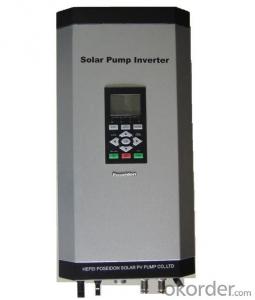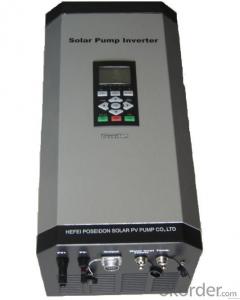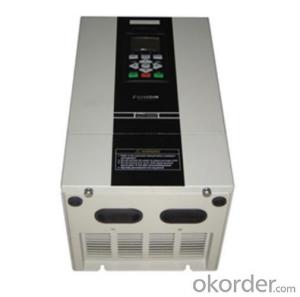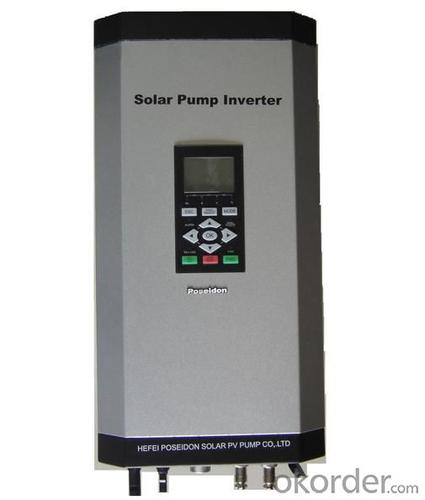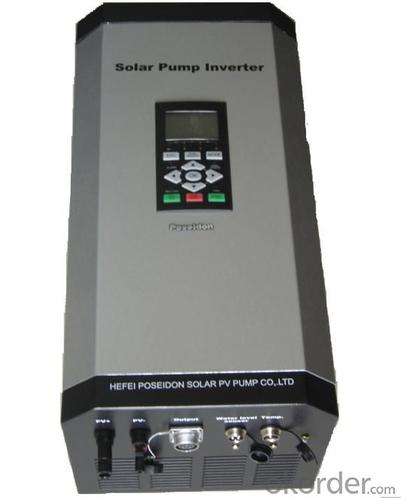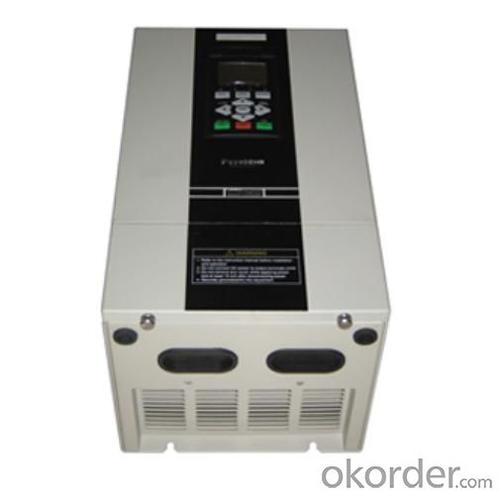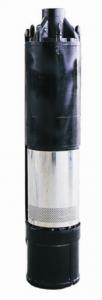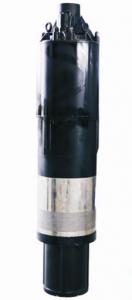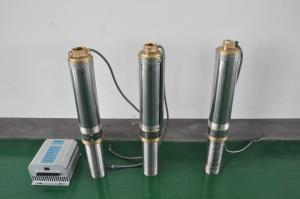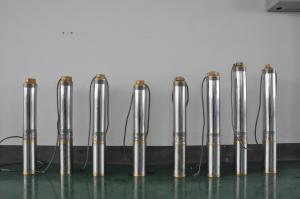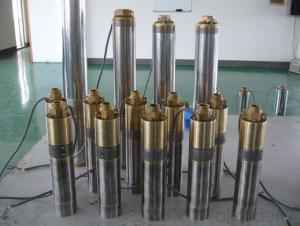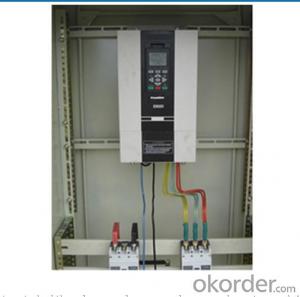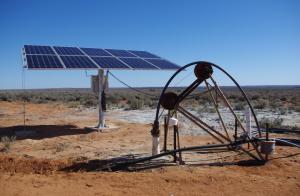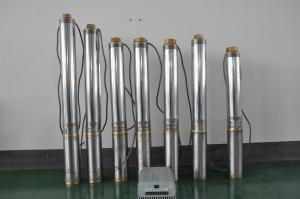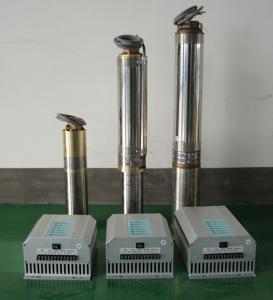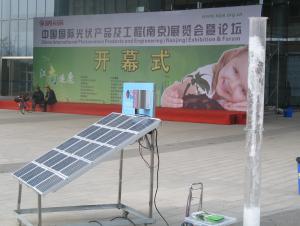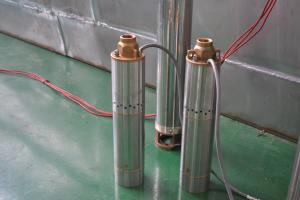Solar Pump for Pool FCPM5K5H Inverter
- Loading Port:
- China Main Port
- Payment Terms:
- TT OR LC
- Min Order Qty:
- -
- Supply Capability:
- -
OKorder Service Pledge
Quality Product, Order Online Tracking, Timely Delivery
OKorder Financial Service
Credit Rating, Credit Services, Credit Purchasing
You Might Also Like
Solar pump inverter FCPM5K5H Product Description:
Product Description:
Solar water pumping system is constructed with solar panel array,solar pump inverter and AC water pump, DC current produced from solar panel will be delivered to solar pump inverter,and it will convert it into AC current to drive water pump,and will automatically regulate output frequency according to sun radiance intensity,maximally realize MPPT tracking function.
Product Features
Adopting the proposed dynamic VI maximum power point tracking (MPPT) control method, with fast response, and reliable operation, achieves efficiency of 99%.
Designed with variable frequency driver, greatly improves efficiency
Extremely high efficiency
Digital mode control, with automatic operation and manual operation mode options
Complete protection functions
Adopts intelligent IPM module, with high reliability
LCD display and operation panel, in real time presents operating data
Optional for water level measurement and control circuit
Applicable for general ACC pumps, like centrifugal pump, piston pump etc.
Independent intellectual property; Highly effective, the redundant reliability, exempts the maintenance and the long life.
The pumps are soft started, fully protected.
No batteries are used. So better Sunlight, more water
Datasheet.
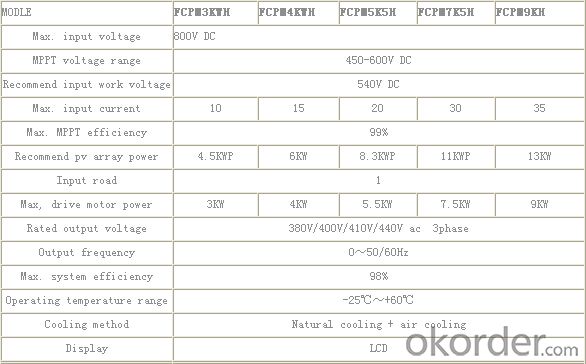
- Q: Can a solar pump be used for water supply in disaster-stricken areas?
- Indeed, in disaster-stricken areas, a solar pump has the capability to cater to water supply needs. These pumps are a dependable and sustainable alternative for ensuring access to water in areas where conventional power sources may be disrupted or unavailable. By harnessing solar energy, these pumps operate without the need for fuel or electricity, making them cost-effective and environmentally friendly. In areas struck by disasters, the availability of clean water is often an urgent requirement. Solar pumps can be utilized to extract water from wells, boreholes, or other water sources, and subsequently distribute it to communities for various purposes such as drinking, irrigation, etc. Their installation and operation are hassle-free, demanding minimal maintenance and devoid of ongoing fuel expenses. Moreover, solar pumps can be equipped with storage systems, enabling the collection and preservation of water during daylight hours for later use during unfavorable conditions, such as at night or on overcast days. This guarantees an uninterrupted and dependable water supply, even in challenging circumstances. Furthermore, solar pumps can be seamlessly integrated with water purification systems, thus providing clean and safe drinking water in disaster-stricken areas where water sources may be contaminated. The amalgamation of solar pumping and water purification can significantly enhance the overall water supply situation and contribute to the prevention of waterborne diseases. All in all, solar pumps present a practical and sustainable solution for water supply in disaster-stricken areas. They furnish a reliable water source without relying on traditional power sources, making them an ideal choice for ensuring access to clean water during emergency situations.
- Q: Does a solar pump require a separate controller?
- Typically, in a solar pump setup, a separate controller is required. Its role is to regulate the power supply to the pump, ensuring efficient operation. By controlling the speed, pressure, and flow of the pump, it can be adjusted to meet specific requirements. Furthermore, the controller functions as a safety measure, safeguarding the pump against overcurrent, overheating, and other potential problems. Moreover, it may offer additional features such as timers, sensors, and remote monitoring capabilities, enhancing the system's functionality and performance. Consequently, a separate controller is indispensable in a solar pump setup.
- Q: Can a solar pump be used for aquaculture?
- Indeed, aquaculture can indeed benefit from the use of solar pumps. These pumps present a sustainable and cost-efficient solution for powering water circulation and aeration systems within aquaculture ventures. By harnessing solar energy, these pumps effectively transport and circulate water, which is of utmost importance in maintaining the overall quality, oxygen levels, and temperature in aquaculture setups. The versatility of solar pumps allows them to be employed across various aquaculture applications, including fish farms, shrimp farms, and hatcheries. By reducing reliance on traditional electricity sources and diesel generators, solar pumps effectively decrease operational expenses and minimize carbon emissions. Moreover, the ease of installation in remote or off-grid locations positions solar pumps as an optimal choice for aquaculture operations in rural areas or developing nations.
- Q: Are there any water quality requirements for a solar pump?
- Yes, there are water quality requirements for a solar pump. It is important to ensure that the water being pumped is clean and free from contaminants such as debris, sediments, and chemicals. This is essential to prevent damage to the pump and ensure its optimal performance and longevity. Additionally, the quality of water being pumped may also impact the overall efficiency and effectiveness of the solar pump system. Therefore, it is advisable to regularly conduct water quality tests and implement appropriate filtration or treatment measures if necessary.
- Q: Can a solar pump be used for geothermal heating or cooling systems?
- No, a solar pump cannot be directly used for geothermal heating or cooling systems. Geothermal systems use the Earth's natural heat to provide heating or cooling, whereas solar pumps are designed to harness energy from the sun. The technologies and mechanisms involved in these systems are different, making them incompatible for direct use with each other.
- Q: How does the efficiency of a solar pump compare to a traditional pump?
- The efficiency of a solar pump is generally higher compared to a traditional pump. Solar pumps utilize energy from the sun, which is a renewable resource, to operate. This means that they do not rely on fossil fuels or electricity from the grid, resulting in reduced energy consumption and lower operating costs. Solar pumps are designed with advanced technology and are specifically engineered to optimize energy conversion. They use photovoltaic cells to convert sunlight into electricity, which powers the pump. This direct conversion eliminates the need for mechanical or electrical energy transmission, reducing energy losses and increasing overall efficiency. Traditional pumps, on the other hand, typically rely on electricity from the grid or fossil fuel-powered engines. These pumps may be less efficient due to energy losses during generation, transmission, and conversion processes. Additionally, traditional pumps often require more maintenance and have higher operational costs, as they are dependent on external energy sources. Furthermore, solar pumps are often more environmentally friendly compared to traditional pumps. They do not emit greenhouse gases or pollutants during operation, contributing to a cleaner and more sustainable energy solution. While the efficiency of solar pumps can vary depending on factors such as design, size, and application, they generally offer higher efficiency and lower operating costs compared to traditional pumps.
- Q: Is a solar pump easy to install?
- Yes, a solar pump is generally easy to install. It does not require complicated wiring or extensive plumbing work. The installation process involves mounting the solar panel and connecting it to the pump using simple connectors. Additionally, there is no need for an external power source, making it a convenient and hassle-free installation.
- Q: Can a solar pump be used for mining applications?
- Indeed, mining applications can make use of a solar pump. When it comes to pumping water or other fluids in mining operations, solar pumps offer both an eco-friendly and budget-friendly alternative. They have the ability to supply water for various mining processes, including dust suppression, ore processing, and equipment cooling. By employing photovoltaic panels, solar pumps convert sunlight into electrical energy, which in turn powers the pump. This eliminates the need for fuel or electricity, making them suitable for mining sites located in remote areas or with limited access to power grids. Moreover, solar pumps are self-sufficient and can be easily installed, maintained, and relocated as needed. Implementing solar pumps in mining applications not only reduces carbon emissions and operating costs, but also fosters sustainability within the mining industry.
- Q: Can a solar pump be used in areas with limited access to water testing facilities?
- Yes, a solar pump can be used in areas with limited access to water testing facilities. While it is essential to have access to water testing facilities to ensure the quality and safety of the water being pumped, a solar pump can still be used to extract water from sources such as wells, rivers, or lakes. However, without regular water testing, it becomes challenging to monitor and verify the quality of the water being pumped. It is recommended to establish alternative ways to test water quality, such as portable field testing kits or periodic sampling and sending samples to nearby testing facilities.
- Q: How does the angle of the solar panel affect the performance of a solar pump?
- The angle of the solar panel significantly affects the performance of a solar pump. The optimal angle is determined by the geographical location and the time of year. When the solar panel is inclined at the correct angle, it maximizes the exposure to sunlight, resulting in increased energy generation and efficiency for the solar pump.
Send your message to us
Solar Pump for Pool FCPM5K5H Inverter
- Loading Port:
- China Main Port
- Payment Terms:
- TT OR LC
- Min Order Qty:
- -
- Supply Capability:
- -
OKorder Service Pledge
Quality Product, Order Online Tracking, Timely Delivery
OKorder Financial Service
Credit Rating, Credit Services, Credit Purchasing
Similar products
Hot products
Hot Searches
Related keywords
